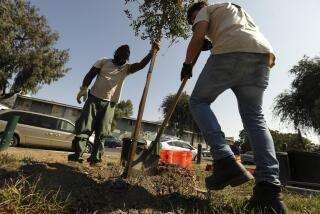War on a Tree Killer Shifts
Four years after arriving from Australia, the psyllids are still snacking their way through eucalyptus groves from San Clemente to the San Fernando Valley. And as the tiny pests continue to suck the life out of thousands of the trees, the battle to save the victims has grown increasingly desperate.
Arborists have attacked the red gum and spotted gum lerp psyllids with a variety of weapons, including imported psyllid-eating wasps also from Australia. But the wasps failed to reproduce enough to overwhelm the growing psyllid population.
Now, as the infestation enters its fifth year, homeowners, community associations and state park officials are having trees injected with a pesticide called Imicide in a last-ditch attempt to save the eucalyptus.
In Lake Forest, considered by many to be on the front line in the battle, homeowners are reporting moderate success with the injections. The treatment involves drilling small holes around the trunk of the tree and inserting a capsule that works the pesticide into the tree’s root system. In a matter of weeks, the chemical works its way into the sap and is ingested by the psyllid, killing it.
“The chemicals are working,” said Patty Martinez, who has lost 30 of her 40 eucalyptus trees to the psyllid and has paid $3,000 to have the withered trees removed. “I know there’s always some controversy about using chemicals, but they’ve saved some of our trees.”
The injections are the latest tactic in the war against the psyllid, which has ravaged trees up and down the state since turning up in El Monte four years ago. In Los Angeles alone, officials with the Department of Recreation and Parks estimate that more than 30,000 trees have been infested and most will have to be removed.
*
Cutting Them Down Is Reluctant Choice
“We don’t like cutting trees, but if they prove to be a hazard, we have to remove them,” said Teresa Proscewicz, principal forester for the Parks Department. “We are in the process of removing over 1,000 trees right now in our parks.”
At the Arboretum of Los Angeles County in Arcadia, which has the most extensive eucalyptus grove outside Australia with about 200 species and 1,000 trees, about a third of those trees have been attacked by the psyllid.
Donald Dahlsten, a professor with the UC Berkeley Center for Biological Control who leads the wasp offensive, said it is still too early to tell how effective the wasps can be.
The psyllid population appears to have thinned, but Dahlsten said he is uncertain whether it’s the climate, the wasps or the fewer numbers of eucalyptus left standing.
Tired of waiting for nature to take its course, some have turned to pesticides.
“I think we’ve saved about 1,500 trees in Lake Forest alone,” said Tim Wilkes, whose San Clemente-based company, Greenscapes, has been administering the $50 injections to trees across Orange County.
Wilkes injected a stand of 70 trees at Doheny State Beach in Dana Point last month and will soon hit San Clemente State Beach.
Much of the latest damage is being done by the spotted lerp psyllid, first discovered in Southern California two years ago by the Center for Biological Control. The spotted variety prefers the lemon gum eucalyptus.
“You’ll see the new guy, the spotted lerp, in town everywhere,” Wilkes said. “The red gum lerp psyllid has done its damage. It’s hard to find a red gum eucalyptus in Orange County that hasn’t been infested.”
The psyllid begins its attack on the eucalyptus by draining the fluid from the long, finger-like leaves, laying eggs and covering them with a sticky white wax--the lerp. On any given leaf, there can be 20 or 30 lerps.
Laurie Smith, chairwoman of the Lake Forest Community Assn.’s tree committee, knows the psyllid lifestyle all too well. Smith has lost 200 of her 265 trees. Her association has removed more than 2,700 trees from common areas and 1,000 more have been identified as lifeless. Smith’s neighbor on Woodglen Circle has 100 dead trees that are ready for the chainsaw.
*
‘Now It’s Just a Meadow of Stumps’
“When I moved in here, I felt like I was nesting in the woods,” said Smith, who has spent $7,000 removing and replanting trees, spraying them with horticulture oil and Orothane, and re-landscaping her yard. “I had sliding glass doors and no curtains. Now I’ve had to make adjustments inside and outside because, suddenly, there’s constant sunshine.”
The scene across the street is even worse, Smith said.
“There was a common area between two houses that was basically a forest of 400 trees,” she said. “Now it’s just a meadow of stumps.”
Nine homeowner associations in Lake Forest have asked for a $275,000 state grant to help with the next phase: replanting.
In Irvine, eucalyptus trees in the city’s parks, greenbelts, streetscapes and trails have also taken a hit. But city officials say they are fortunate compared with the rest of the region.
“We’ve lost about 700 trees and we’re replanting them one-to-one,” said city forester Steve Bourke, who estimates that Irvine has spent about $100,000 on the psyllid battle. “It’s a problem, but it’s not catastrophic. It’s not like it’s decimating our urban forest.”
Bourke said the city kept waiting for the wasps to take care of business. But 18 months after they were released in the Irvine-Tustin area by the Center for Biological Control at UC Berkeley, no relief is in sight.
“I guess they didn’t survive, migrate or reproduce,” Bourke said. “So we’re turning to the Imicide injections.”
Meanwhile, Lake Forest residents say something had better be done soon or their town will lose the “Forest” in its name.


